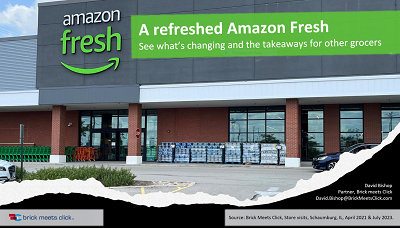Heads Up: 5 key changes in how Aldi does business
Complete the form below to instantly download this month's dashboard.

When it comes to Aldi, it’s time to “mind the gap.” Why? Aldi has transformed itself in some pretty powerful ways. Sure, its tarted as an ELDP retailer that offered an extremely limited assortment at extremely low prices, but – that’s not how it’s operating today. Aldi has evolved into a promotional merchant with a strong price reputation which makes it an increasingly formidable grocery competitor.
The net result is an extremely disruptive force in an increasingly competitive landscape in which the traditional grocery players are being squeezed between two growing pressures – how to pay for additional services like online grocery and how to match low prices.
Fellow retail veteran Bill Bolton and I recently sat down for an in-depth discussion about some of the changes we’ve seen Aldi make. We came up with the five changes listed below, each of which creates its own competitive advantage, but the combined the impact is exponential – especially given the hard reality of an overbuilt market where more stores are becoming less economically viable each month/quarter/year.
1. Changing product mix
The change in Aldi’s product mix shows up clearly in the physical layout of their stores. The space allocation of five to ten years ago has been completely revised.
Aldi now has a full-scale produce department that is approaching 100 items. They’ve done extensive work in pre-packaged meats and expanded in dairy. They’ve also done extensive work with frozen foods. They even stock wine and beer in some locations.
Aldi has also replaced almost an entire aisle of groceries in the center of the store with general merchandise, and increased their attention to the first aisle. And, they’ve expanded their specialty/premium product lines that allow shoppers to trade up.
2. Shift to gross margin strategy
Aldi continues to practice aggressive cost management and still has only a fraction of the assortment a traditional supermarket offers. They now manage their merchandising mix in a different way.
- Aldi generates gross profit from the first aisle, general merchandise, perimeter and premium products – this allows them to reach some of their really aggressive price points and deliver them even more effectively.
- They are generating profit reserves early in the month on sales of higher-margin products that they use to drivetraffic in weeks 3 and 4 with lower-price, lower-margin products as consumer spending slows down.
You can see this play out in their ad circulars – the number of pages changes depending on which week of the month it is. At the beginning of the month there’s plenty of money in the consumer market, but by the end it runs out and retailers have to fight for their share of trips and spending.
So, at the beginning of the month when Aldi is trying to make sure it gets a bigger basket, the circulars are 12 pages, and they promote a lot of higher margin items and general merchandise. By the end of the month, the circulars are down to 8 pages, and they promote the lowest prices of the month, especially on staples. For example, milk at $1.49 per gallon will generate traffic, but Aldidoesn’t offer that at the beginning of the month because they don’t need to.
3. Reinforcing the low price reputation
Aldi reinforces their low price reputation by combining aggressive promotional pricing with strong shelf pricing for basic staples.
For example,they’ll promote milk, eggs, bananas, avocados, and meat, which are highly consumable products that have recognizable price points. No customer has 5,000price points in their head, but they probably have these. And, Aldi is very sensitive to the local competition’s prices on these products. It looks likethe store manager has the discretion to price eggs, milk, bananas, and maybe some of their meat products so that they can beat the competition.
Aldi also reinforces their everyday low price reputation by focusing on certain staple grocery items that are often on the shopping list like flour, sugar, etc.
4. Promotional capabilities & total store merchandising
Promotional retailers typically chart out traffic and ticket sizes for each week and market to themes to accomplish their objectives over the course of, say, a month, by driving traffic to certain areas.
When it comes to promotional themes and merchandising, Aldi seems to do a very natural job of mixing different types of products across what would be departments in a traditional grocery. The merchandising themes in their ads are more about communicating with the customer about what’s important to them and less about allocating space among departments.
For example,take Mother’s Day – they started with one page in the circular several weeks in advance, and as the day approached they introduced other themes, including treating mom to breakfast in bed. Eventually several pages of the circular were devoted to it. We saw a similar build-up to Father’s Day.
Aldi is becoming more and more sophisticated as a total store merchandising team, as opposed to the old-style grocery merchandising, and it’s having a profound impact. It doesn’t look like they are organized the way that grocery stores usually are, with their silos of meat departments, produce departments, grocery departments, wine and beer departments,etc. The traditional supermarket circular is all about dividing up the space between departments – look through Aldi’s flyer, and you’ll see they don’t follow those “rules.”
5. Strong communications with shoppers
Aldi is really good at communicating and connecting with shoppers. Plus, they’re not constrained by the departmental silos. They can orchestrate across the entire store without worrying about whether the deli department will support the idea or the produce person will give the additional space. Total store merchandising is something that traditional retailers are trying to do, but the territorial nature of the departments limits what they can achieve.
When you visit as many stores as we have in the past weeks, you can see the different ways that retailers use their stores to talk to customers and Aldi stands out as doing a really effective job. Throughout the entire Aldi shopping experience there are messages that explain what Aldi is doing that is of benefit to their shoppers. In contrast, some retailers talk about item and price and that’s all. Others explain how they do what they do (like grinding beef every 3 hours.
Aldi is also focusing on on-trend products. For example, they’re carving out a strong position around the theme of feel good and healthy, focusing on fresh, sustainability, organics, no trans fats, no MSG, no hormones, no artificial coloring.They are using their advertising, signage and even a free lifestyle magazine with healthy recipes and articles by dieticians to give their customers info they might otherwise get from a Whole Foods, Stop & Shop, or Lunds & Byerlys.
What's ahead?
Disruption and more fragmentation on the price dimension
In addition to the changes discussed above, Aldi is also attracting more shoppers and more spending by expanding the number of stores, accepting credit/debit cards, and even selling bags to those who want them.
While Amazon gets credit as a significant disruptor, Aldi is creating and will continue to create potentially even more disruption by blending their highly efficient cost control strategies with some softer selling and merchandising techniques.
When the opening price points in a market are owned by Aldi, it leaves everyone else in the market trying to figure out how to respond. This is why it is important to mind the gap between the old Aldi and the new Aldi. Disruption in the grocery industry is coming from many directions – and it includes Aldi as well as Amazon. What do you think?












